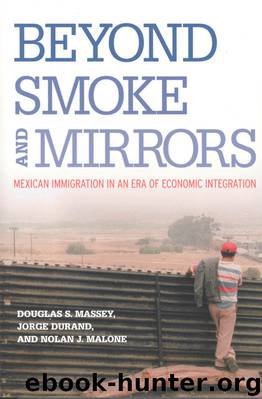Beyond Smoke and Mirrors: Mexican Immigration in an Era of Economic Integration by Douglas S. Massey & Jorge Durand & Nolan J. Malone

Author:Douglas S. Massey & Jorge Durand & Nolan J. Malone [Massey, Douglas S.]
Language: eng
Format: azw3, mobi
ISBN: 9781610443821
Publisher: Russell Sage Foundation
Published: 2002-03-14T05:00:00+00:00
Prevention Through Deterrence Early in the Clinton administration (in 1993 and 1994), the INS developed a new border strategy that came to be known as “prevention through deterrence.” The idea was to prevent Mexicans from crossing the border illegally in order to avoid having to arrest them later (Andreas 2000). The strategy began in September 1993, when the Border Patrol chief in El Paso, Silvestre Reyes, on his own initiative launched “Operation Blockade” as an all-out effort to prevent illegal border crossing within El Paso, Texas. Within a few months immigrants had been induced to go around Silvestre’s imposing wall of enforcement resources, and traffic through El Paso itself was dramatically reduced.
The policy was extremely popular with El Paso’s residents. Although they were overwhelmingly of Mexican origin themselves, they had grown weary of the unwelcome visitors. A survey carried out by a local nonprofit organization revealed that what bothered El Paso residents was not undocumented migrants per se, but the fact that they frequently stopped in yards to drink water and rest. It was thus the invasion of private space that people did not like; if the migrants had been invisible or remained in public areas, few would have cared.
As a result of the operation, Reyes was lauded as a local hero and ultimately went on to be elected to Congress. Naturally his superiors in Washington, D.C., took note of the favorable publicity and the apparent success of Operation Blockade. After being renamed “Operation Hold-the-Line,” to assuage Mexican sensibilities, its strategy and tactics were incorporated into the Border Patrol’s strategic plan for 1994 (U.S. Border Patrol 1994). In October of that year the INS launched a second operation using the approach pioneered by Silvestre Reyes in El Paso, this time along the busiest stretch of border in San Diego.
“Operation Gatekeeper” saw the installation of high-intensity floodlights to illuminate the border day and night, as well as an eight-foot steel fence along fourteen miles of border from the Pacific Ocean to the foothills of the Coast Ranges. Border Patrol officers were stationed every few hundred yards behind this formidable wall (which came to be known as the “tortilla curtain”), and a new array of sophisticated hardware (motion detectors, infrared scopes, trip wires) was deployed in the no-man’s-land it fronted (see Dunn 1996). As in El Paso, the operation was a huge success. From being the busiest point on the entire border, San Diego became positively tranquil, even boring, for Border Patrol officers who were forced to sit in their vehicles staring at a blank wall for hours on end. Operation Gatekeeper put an end to the chaotic images of migrants running through traffic that had so troubled California’s voters. Once again, the border appeared to be “under control.”
Of course, throwing up blockades in El Paso and San Diego did not really stop undocumented migrants from entering the United States; it simply channeled them to other, less visible locations along the two-thousand-mile border. Passage through remote mountains, high deserts, and raging rivers
Download
Beyond Smoke and Mirrors: Mexican Immigration in an Era of Economic Integration by Douglas S. Massey & Jorge Durand & Nolan J. Malone.mobi
This site does not store any files on its server. We only index and link to content provided by other sites. Please contact the content providers to delete copyright contents if any and email us, we'll remove relevant links or contents immediately.
| Anthropology | Archaeology |
| Philosophy | Politics & Government |
| Social Sciences | Sociology |
| Women's Studies |
Cecilia; Or, Memoirs of an Heiress — Volume 1 by Fanny Burney(31374)
Cecilia; Or, Memoirs of an Heiress — Volume 3 by Fanny Burney(30969)
Cecilia; Or, Memoirs of an Heiress — Volume 2 by Fanny Burney(30923)
The Great Music City by Andrea Baker(22458)
We're Going to Need More Wine by Gabrielle Union(18110)
Bombshells: Glamour Girls of a Lifetime by Sullivan Steve(13142)
Pimp by Iceberg Slim(12974)
All the Missing Girls by Megan Miranda(12814)
Fifty Shades Freed by E L James(12479)
Talking to Strangers by Malcolm Gladwell(11955)
Norse Mythology by Gaiman Neil(11940)
Crazy Rich Asians by Kevin Kwan(8396)
Mindhunter: Inside the FBI's Elite Serial Crime Unit by John E. Douglas & Mark Olshaker(7874)
The Lost Art of Listening by Michael P. Nichols(6513)
Enlightenment Now: The Case for Reason, Science, Humanism, and Progress by Steven Pinker(6434)
Bad Blood by John Carreyrou(5801)
The Four Agreements by Don Miguel Ruiz(5551)
Weapons of Math Destruction by Cathy O'Neil(5078)
We Need to Talk by Celeste Headlee(4904)
